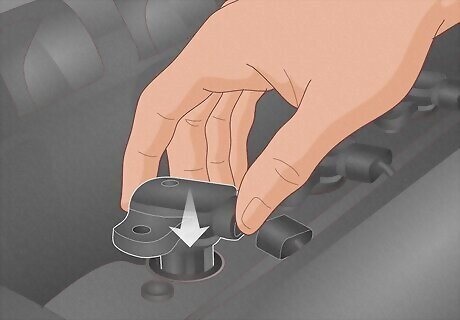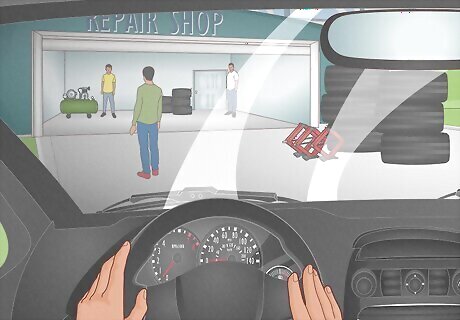
views
Symptoms of Bad Coil Pack

Check Engine Light Ignition coil packs, or single coils (depending on your vehicle's make and model), are on top of the engine block in most modern cars. When your coil misfires or is faulty, it can be enough to trigger the Check Engine Light on your dashboard. This light can range from minor to major issues, so it's always best to pull over and get it checked immediately. Newer car models have Check Engine lights in different colors to help you understand the severity of the problem. A flashing or red light is a sign to take your car in immediately. Meanwhile, a solid yellow or orange may indicate more minor issues, like a loose gas cap.

Misfiring engine If you notice a jerking or sputtering feeling when driving at average speeds, this is one of the critical signs of an engine misfire. It can also include a coughing or consistent vibration when it's parked, idling, or while you're driving. Gasoline cars have an internal combustion engine ignited by a spark from the spark plugs. When your car misfires, one of the cylinders isn't working correctly.

Poor gas performance Are you having to fill up on gas more often? This could be an indication of a bad coil pack. With every misfire, the more fuel that's being used and lost. In turn, your vehicle's combustion efficiency drops, leading to increased emissions. High emissions are not only bad for your car but the environment, too.

Reduced power Have you tried accelerating on the highway but felt your car sputtering or struggling to catch up to speed? This may be a result of a failing ignition coil. Leaving the issue unaddressed can cause significant damage to the engine, such as overheating or misfires, and cause an accident.

Sudden backfires A backfire is a loud bang that results in power loss. The loud bang signals that unburned fuel suddenly escaped the exhaust system. This happens when the vehicle's internal combustion system isn't working correctly.

Hard starts and stalling Is your car taking longer to start or has difficulty turning on in cold weather? This is a common issue in older vehicles with high mileage or single ignition coils. Coils connect to the spark plugs, which are required to make a spark that powers the car.
How to Replace a Damaged Ignition Coil

Disconnect the car battery's negative cable. Before tinkering under your vehicle's hood, turn the ignition off. It's best to allow the engine to cool down to avoid accidentally burning yourself. To avoid electrical mishaps, take a 10-millimeter open-end wrench to unbolt the negative "-" cable. If your vehicle has plastic caps covering the battery terminals, remove them so you can unbolt the cable.

Locate the ignition coil. On older vehicles made before the 1990s, ignition coils are found between the battery and a distributor. However, in modern cars, the coil is attached to the top of each pair of spark plugs, located near the top of the engine, and bolted into the cylinder head. In some vehicles, spark plugs may be hidden by wires or a plastic cover. Refer to your owner's manual for the exact placement.

Remove the ignition coil with a twisting motion. First, squeeze the electrical plastic pigtail connector and pull it towards you. Then, use an open-ended wrench to remove the bolts. Set the bolts to the side. With your hand, remove the ignition coil by twisting it in a counter-clockwise position. Once it's loose, you can pull the coil out.

Apply di-electric grease to the new coil. To protect against corrosion and ensure good condition, add a dab of di-electric grease to the bottom of the new coil and its electrical socket. Use your finger or a clean microfiber cloth to distribute the grease evenly. Some ignition coils come pre-greased, so refer to the product's packaging for more information.

Slide the new coil into its housing. The same way you pulled the old coil out, slide the new coil into its place with your finger. You should feel it sit around the spark plug. Rescrew the bolt to keep the coil in place and reattach the pigtail connector. You'll hear a click when it's connected. If replacing more than one coil, replace each one at a time to ensure you're not confusing the oil coils with the new ones. After the coil is successfully attached, you can start your car to ensure it's working correctly.
What do ignition coils do?

An ignition coil pack transforms a battery's voltage output to start the car. A standard car's battery contains 12 voltages, which works to keep all of the electrical components functioning. That doesn't seem like a lot of power to start a car, does it? Well, that's where the ignition coil pack comes in. This small device transforms the battery's output into 45,000 volts! When it reaches this high-tension current, all the power transfers to the engine's spark plugs that get the car started.
Why do ignition coils fail?

A vehicle's ignition coil fails after 80,000 to 100,000 miles. The more you use your vehicle, the more it heats up, and two things these coils hate are heat and vibration. Over time, the temperature and vibration can damage the coils, creating cracks that allow moisture to seep in. Similarly, coil failure can be caused by damaged spark plugs or wires with excessive gaps, making it harder for the coils to connect.
Can you drive with a bad coil pack?

Driving with a bad coil pack is possible for short-term use. It’s possible to drive your vehicle with a failed coil, but beware—it’s generally unadvisable since it’s unsafe and damages your engine the longer you leave it unaddressed. For vehicles with a single ignition coil, though, your car might not start, so driving it isn’t an option anyway. If you’re going to drive, stick to local roads and only get behind the wheel when it’s absolutely necessary until you can see a mechanic.
















Comments
0 comment